2017 TOYOTA AURIS HYBRID flat tire
[x] Cancel search: flat tirePage 502 of 664
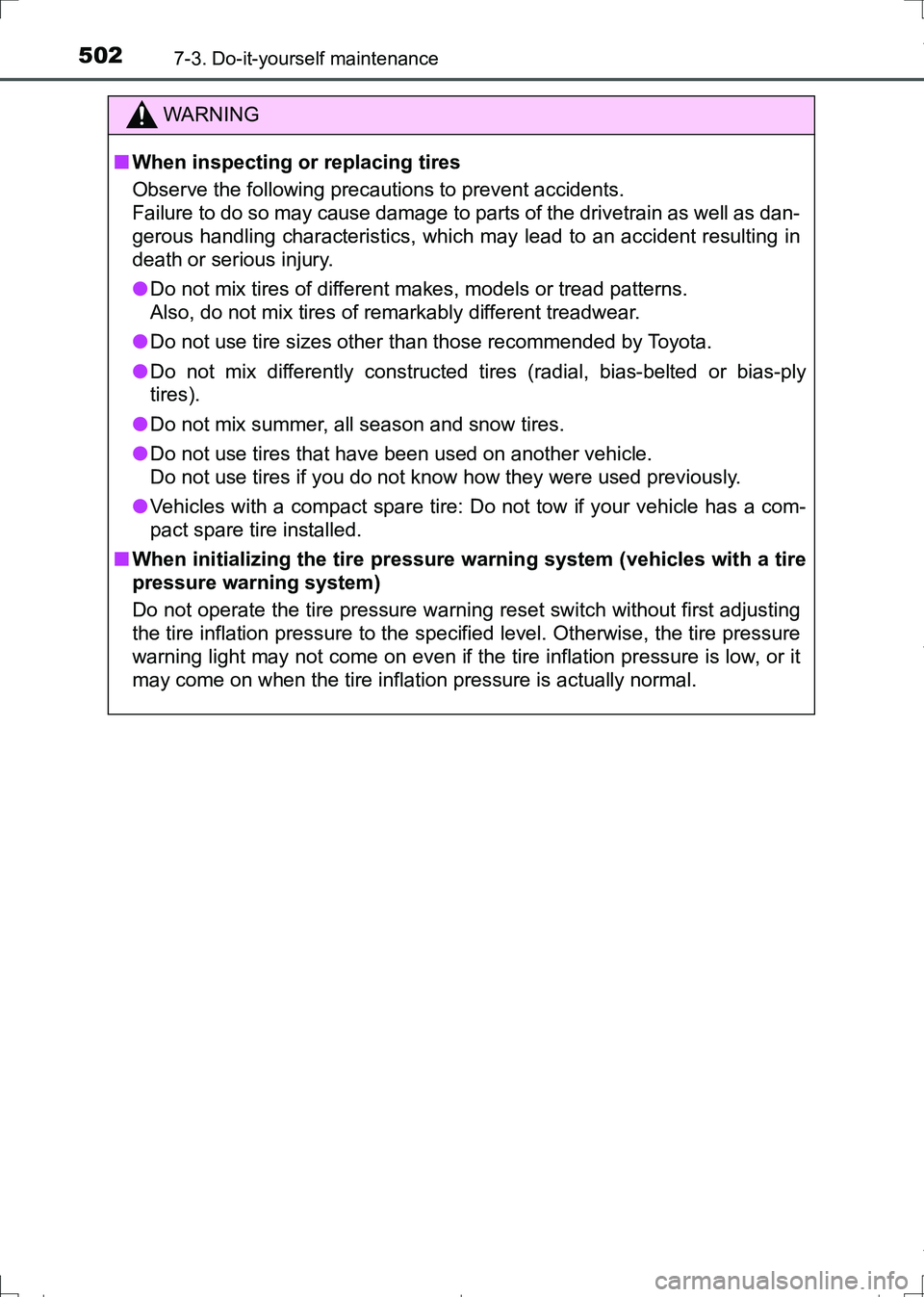
5027-3. Do-it-yourself maintenance
AURIS Touring Sports_EE (12L13E)
WARNING
■When inspecting or replacing tires
Observe the following precautions to prevent accidents.
Failure to do so may cause damage to parts of the drivetrain as well as dan-
gerous handling characteristics, which may lead to an accident resulting in
death or serious injury.
●Do not mix tires of different makes, models or tread patterns.
Also, do not mix tires of remarkably different treadwear.
●Do not use tire sizes other than those recommended by Toyota.
●Do not mix differently constructed tires (radial, bias-belted or bias-ply
tires).
●Do not mix summer, all season and snow tires.
●Do not use tires that have been used on another vehicle.
Do not use tires if you do not know how they were used previously.
●Vehicles with a compact spare tire: Do not tow if your vehicle has a com-
pact spare tire installed.
■When initializing the tire pressure warning system (vehicles with a tire
pressure warning system)
Do not operate the tire pressure warning reset switch without first adjusting
the tire inflation pressure to the specified level. Otherwise, the tire pressure
warning light may not come on even if the tire inflation pressure is low, or it
may come on when the tire inflation pressure is actually normal.
AURIS Touring Sports_OM_Europe_OM12L13E.book 502 ページ 2016年6月27日 月曜日 午後5時21分
Page 503 of 664
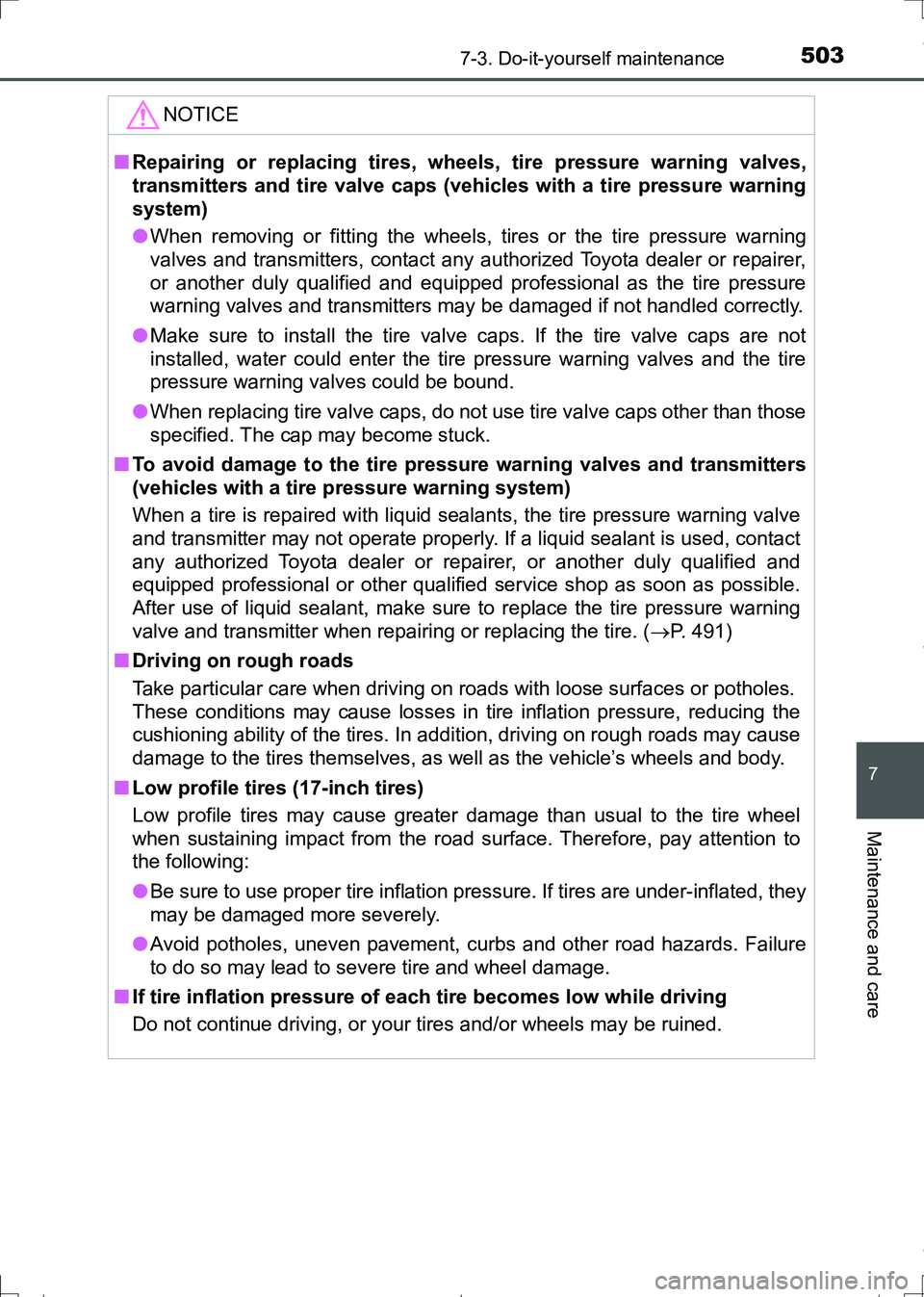
5037-3. Do-it-yourself maintenance
AURIS Touring Sports_EE (12L13E)
7
Maintenance and care
NOTICE
■Repairing or replacing tires, wheels, tire pressure warning valves,
transmitters and tire valve caps (vehicles with a tire pressure warning
system)
●When removing or fitting the wheels, tires or the tire pressure warning
valves and transmitters, contact any authorized Toyota dealer or repairer,
or another duly qualified and equipped professional as the tire pressure
warning valves and transmitters may be damaged if not handled correctly.
●Make sure to install the tire valve caps. If the tire valve caps are not
installed, water could enter the tire pressure warning valves and the tire
pressure warning valves could be bound.
●When replacing tire valve caps, do not use tire valve caps other than those
specified. The cap may become stuck.
■To avoid damage to the tire pressure warning valves and transmitters
(vehicles with a tire pressure warning system)
When a tire is repaired with liquid sealants, the tire pressure warning valve
and transmitter may not operate properly. If a liquid sealant is used, contact
any authorized Toyota dealer or repairer, or another duly qualified and
equipped professional or other qualified service shop as soon as possible.
After use of liquid sealant, make sure to replace the tire pressure warning
valve and transmitter when repairing or replacing the tire. (P. 491)
■Driving on rough roads
Take particular care when driving on roads with loose surfaces or potholes.
These conditions may cause losses in tire inflation pressure, reducing the
cushioning ability of the tires. In addition, driving on rough roads may cause
damage to the tires themselves, as well as the vehicle’s wheels and body.
■Low profile tires (17-inch tires)
Low profile tires may cause greater damage than usual to the tire wheel
when sustaining impact from the road surface. Therefore, pay attention to
the following:
●Be sure to use proper tire inflation pressure. If tires are under-inflated, they
may be damaged more severely.
●Avoid potholes, uneven pavement, curbs and other road hazards. Failure
to do so may lead to severe tire and wheel damage.
■If tire inflation pressure of each tire becomes low while driving
Do not continue driving, or your tires and/or wheels may be ruined.
AURIS Touring Sports_OM_Europe_OM12L13E.book 503 ページ 2016年6月27日 月曜日 午後5時21分
Page 504 of 664
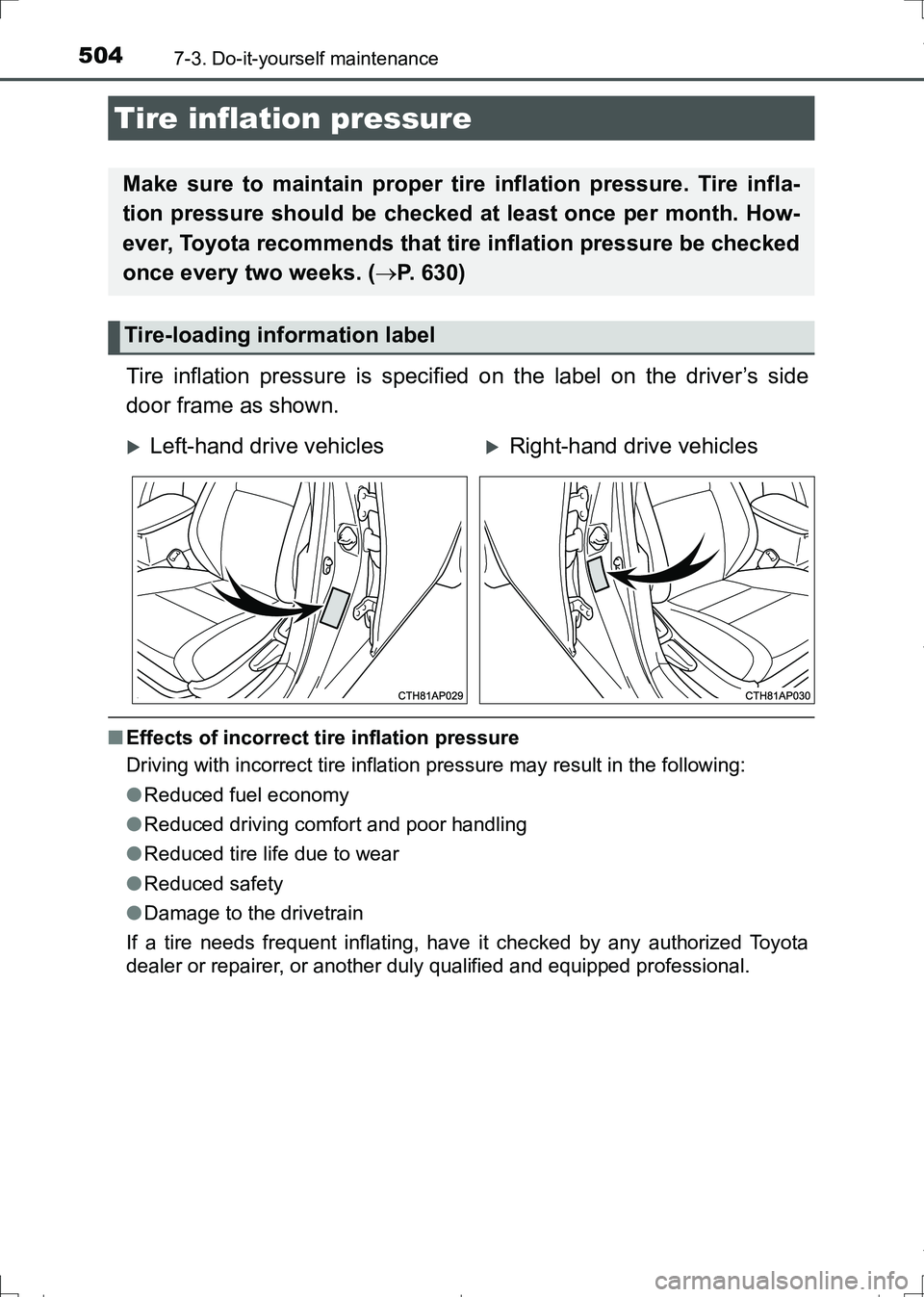
5047-3. Do-it-yourself maintenance
AURIS Touring Sports_EE (12L13E)
Tire inflation pressure is specified on the label on the driver’s side
door frame as shown.
■Effects of incorrect tire inflation pressure
Driving with incorrect tire inflation pressure may result in the following:
●Reduced fuel economy
●Reduced driving comfort and poor handling
●Reduced tire life due to wear
●Reduced safety
●Damage to the drivetrain
If a tire needs frequent inflating, have it checked by any authorized Toyota
dealer or repairer, or another duly qualified and equipped professional.
Tire inflation pressure
Make sure to maintain proper tire inflation pressure. Tire infla-
tion pressure should be checked at least once per month. How-
ever, Toyota recommends that tire inflation pressure be checked
once every two weeks. (P. 630)
Tire-loading information label
Left-hand drive vehiclesRight-hand drive vehicles
AURIS Touring Sports_OM_Europe_OM12L13E.book 504 ページ 2016年6月27日 月曜日 午後5時21分
Page 505 of 664
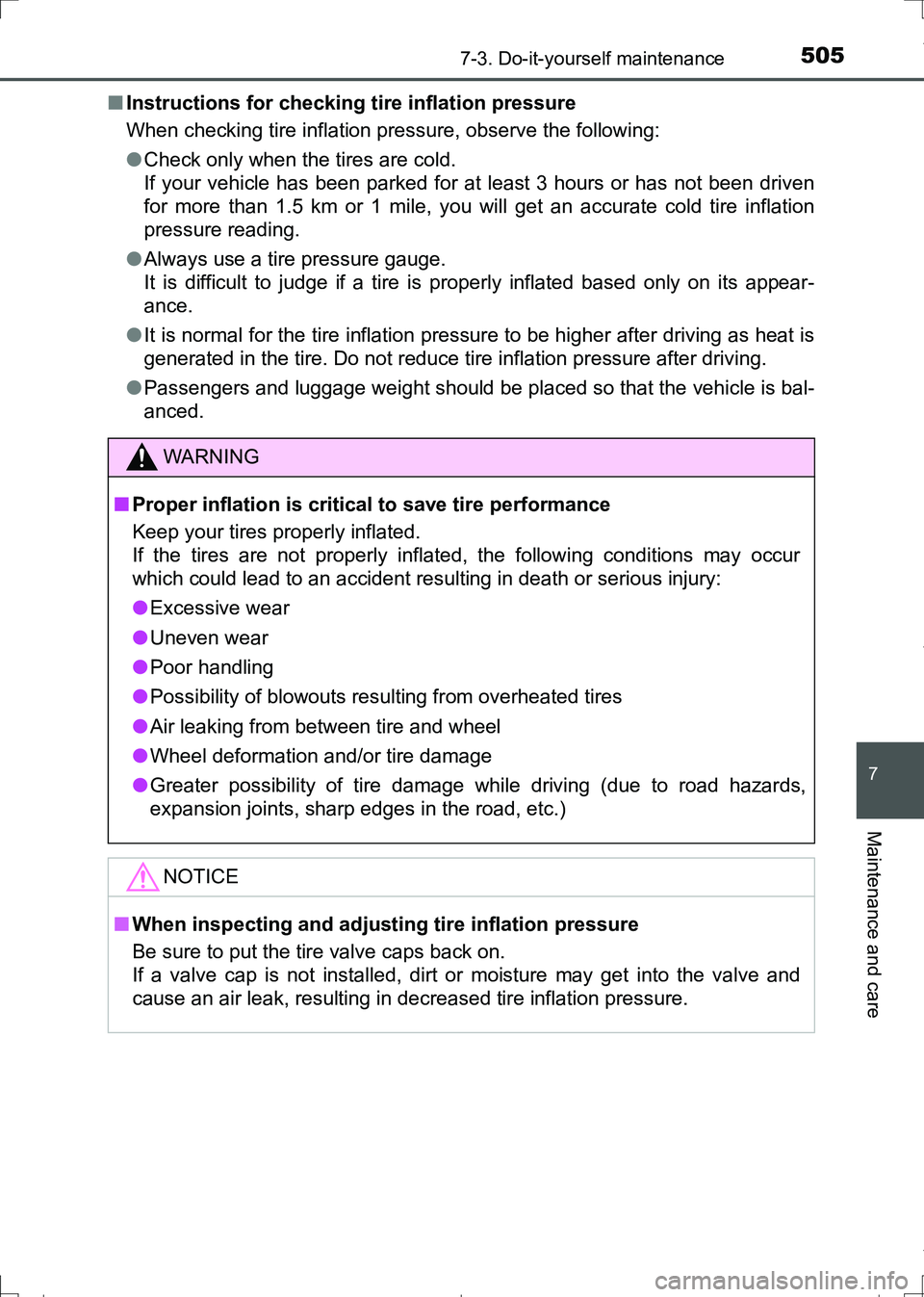
5057-3. Do-it-yourself maintenance
AURIS Touring Sports_EE (12L13E)
7
Maintenance and care
■Instructions for checking tire inflation pressure
When checking tire inflation pressure, observe the following:
●Check only when the tires are cold.
If your vehicle has been parked for at least 3 hours or has not been driven
for more than 1.5 km or 1 mile, you will get an accurate cold tire inflation
pressure reading.
●Always use a tire pressure gauge.
It is difficult to judge if a tire is properly inflated based only on its appear-
ance.
●It is normal for the tire inflation pressure to be higher after driving as heat is
generated in the tire. Do not reduce tire inflation pressure after driving.
●Passengers and luggage weight should be placed so that the vehicle is bal-
anced.
WARNING
■Proper inflation is critical to save tire performance
Keep your tires properly inflated.
If the tires are not properly inflated, the following conditions may occur
which could lead to an accident resulting in death or serious injury:
●Excessive wear
●Uneven wear
●Poor handling
●Possibility of blowouts resulting from overheated tires
●Air leaking from between tire and wheel
●Wheel deformation and/or tire damage
●Greater possibility of tire damage while driving (due to road hazards,
expansion joints, sharp edges in the road, etc.)
NOTICE
■When inspecting and adjusting tire inflation pressure
Be sure to put the tire valve caps back on.
If a valve cap is not installed, dirt or moisture may get into the valve and
cause an air leak, resulting in decreased tire inflation pressure.
AURIS Touring Sports_OM_Europe_OM12L13E.book 505 ページ 2016年6月27日 月曜日 午後5時21分
Page 506 of 664
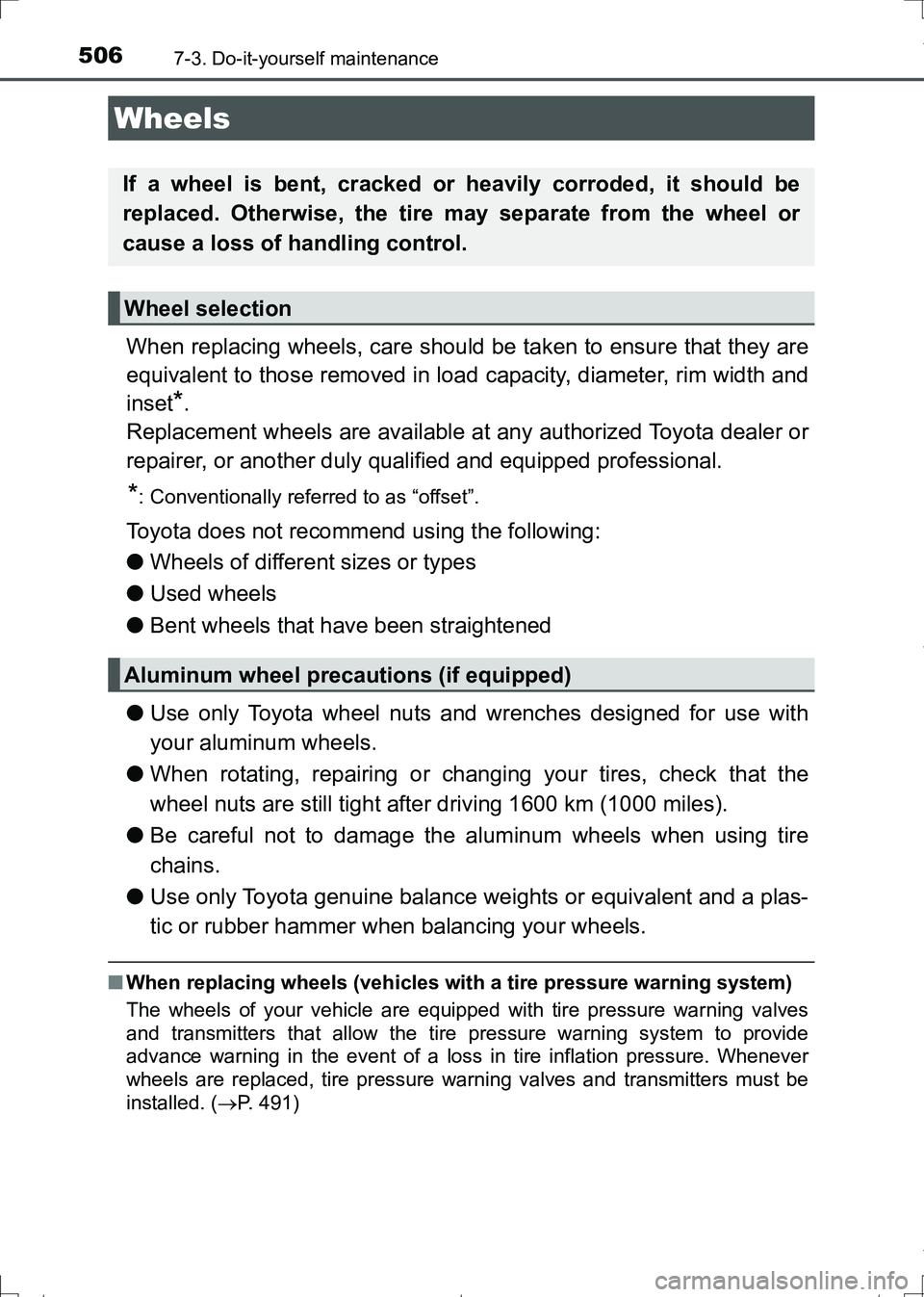
5067-3. Do-it-yourself maintenance
AURIS Touring Sports_EE (12L13E)
When replacing wheels, care should be taken to ensure that they are
equivalent to those removed in load capacity, diameter, rim width and
inset
*.
Replacement wheels are available at any authorized Toyota dealer or
repairer, or another duly qualified and equipped professional.
*: Conventionally referred to as “offset”.
Toyota does not recommend using the following:
●Wheels of different sizes or types
●Used wheels
●Bent wheels that have been straightened
●Use only Toyota wheel nuts and wrenches designed for use with
your aluminum wheels.
●When rotating, repairing or changing your tires, check that the
wheel nuts are still tight after driving 1600 km (1000 miles).
●Be careful not to damage the aluminum wheels when using tire
chains.
●Use only Toyota genuine balance weights or equivalent and a plas-
tic or rubber hammer when balancing your wheels.
■When replacing wheels (vehicles with a tire pressure warning system)
The wheels of your vehicle are equipped with tire pressure warning valves
and transmitters that allow the tire pressure warning system to provide
advance warning in the event of a loss in tire inflation pressure. Whenever
wheels are replaced, tire pressure warning valves and transmitters must be
installed. (P. 491)
Wheels
If a wheel is bent, cracked or heavily corroded, it should be
replaced. Otherwise, the tire may separate from the wheel or
cause a loss of handling control.
Wheel selection
Aluminum wheel precautions (if equipped)
AURIS Touring Sports_OM_Europe_OM12L13E.book 506 ページ 2016年6月27日 月曜日 午後5時21分
Page 533 of 664

533
8When trouble arises
AURIS Touring Sports_EE (12L13E)8-1. Essential information
Emergency flashers ........... 534
If your vehicle has
to be stopped
in an emergency .............. 535
8-2. Steps to take
in an emergency
If your vehicle needs
to be towed ...................... 537
If you think something
is wrong ........................... 543
Fuel pump shut off
system ............................. 544
If a warning light turns on
or a warning buzzer
sounds ............................. 545
If a warning message
is displayed ...................... 557
If you have a flat tire
(vehicles with
a spare tire) ..................... 563
If you have a flat tire
(vehicles with
an emergency tire
puncture repair kit)........... 576If the engine will not
start.................................. 592
If the electronic key does
not operate properly ........ 594
If the vehicle battery
is discharged ................... 597
If your vehicle
overheats ......................... 603
If you run out of fuel
and the engine stalls........ 607
If the vehicle becomes
stuck ................................ 608
AURIS Touring Sports_OM_Europe_OM12L13E.book 533 ページ 2016年6月27日 月曜日 午後5時21分
Page 538 of 664
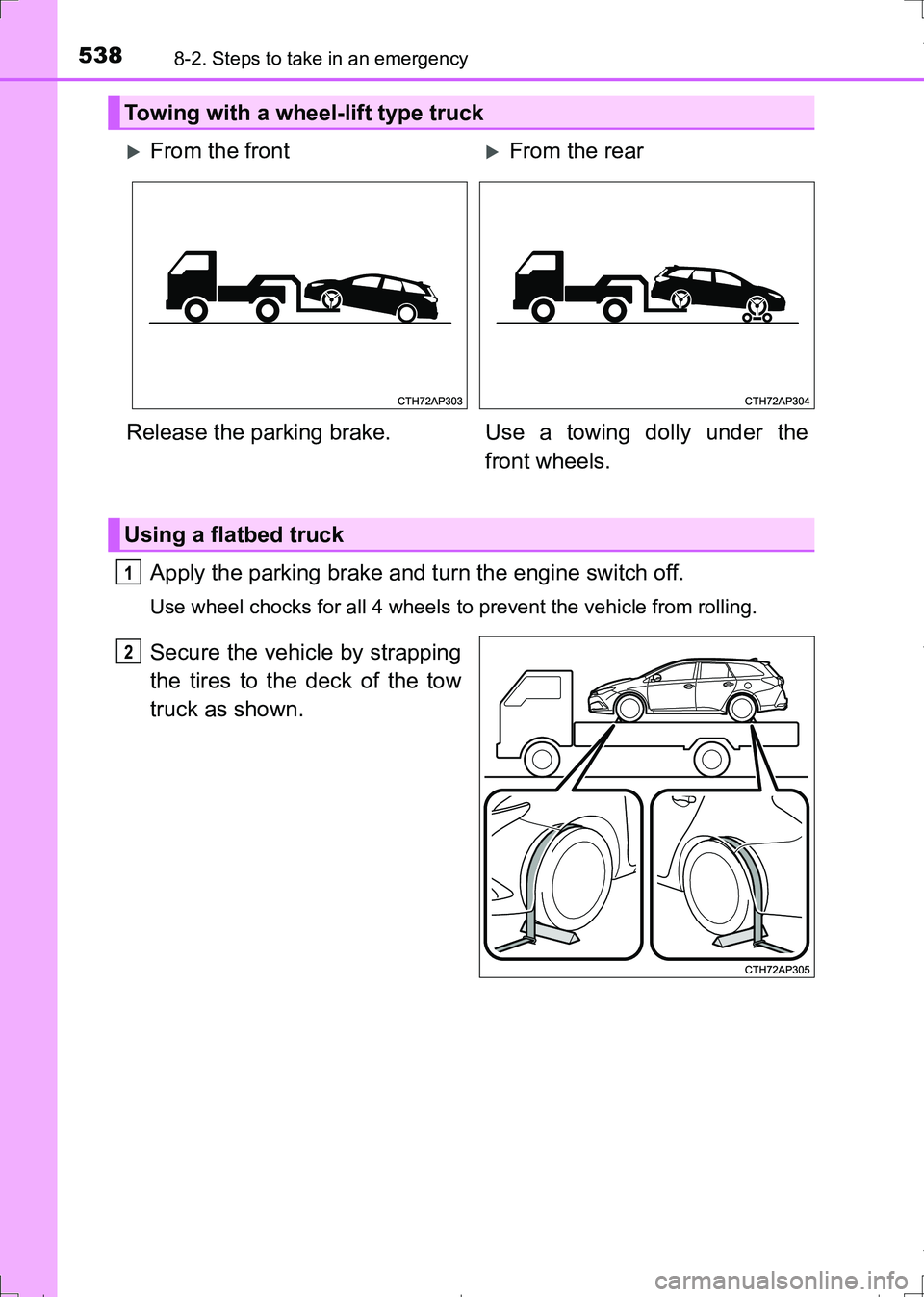
5388-2. Steps to take in an emergency
AURIS Touring Sports_EE (12L13E)
Apply the parking brake and turn the engine switch off.
Use wheel chocks for all 4 wheels to prevent the vehicle from rolling.
Secure the vehicle by strapping
the tires to the deck of the tow
truck as shown.
Towing with a wheel-lift type truck
From the frontFrom the rear
Release the parking brake. Use a towing dolly under the
front wheels.
Using a flatbed truck
1
2
AURIS Touring Sports_OM_Europe_OM12L13E.book 538 ページ 2016年6月27日 月曜日 午後5時21分
Page 542 of 664

5428-2. Steps to take in an emergency
AURIS Touring Sports_EE (12L13E)
NOTICE
■To prevent damage to the vehicle when towing using a wheel-lift type
truck
●Vehicles without a smart entry & start system: Do not tow the vehicle from
the rear when the engine switch is in the “LOCK” position or the key is
removed.
The steering lock mechanism is not strong enough to hold the front wheels
straight.
●Vehicles with a smart entry & start system: Do not tow the vehicle from the
rear when the engine switch is off. The steering lock mechanism is not
strong enough to hold the front wheels straight.
●When raising the vehicle, ensure adequate ground clearance for towing at
the opposite end of the raised vehicle. Without adequate clearance, the
vehicle could be damaged while being towed.
■To prevent damage to the vehicle when towing with a sling-type truck
Do not tow with a sling-type truck, either from the front or rear.
■To prevent damage to the vehicle during emergency towing
Do not secure cables or chains to the suspension components.
■To prevent damage to the vehicle when using a flatbed truck
●Do not drive over wheel chocks, as doing so may damage the tires.
●Do not tie down the vehicle over any parts other than the tires (do not use
parts such as the suspension).
■When towing a vehicle equipped with the Stop & Start system (if
equipped)
Vehicles without a smart entry & start system: When it is necessary to tow
the vehicle with all 4 wheels contacting the ground, perform the following
procedure before towing the vehicle to protect the system.
Turn the engine switch off once, and then start the engine. If the engine
does not start, turn the engine switch to “ON” position.
Vehicles with a smart entry & start system: When it is necessary to tow the
vehicle with all 4 wheels contacting the ground, perform the following proce-
dure before towing the vehicle to protect the system.
Turn the engine switch off once, and then start the engine. If the engine
does not start, turn the engine switch to IGNITION ON mode.
AURIS Touring Sports_OM_Europe_OM12L13E.book 542 ページ 2016年6月27日 月曜日 午後5時21分